Learning to play the guitar is more than just a rewarding hobby; it’s an enriching experience that can boost cognitive function and alleviate anxiety. While the prospect of learning guitar might initially feel overwhelming, with the right guidance and a bit of dedication, anyone can master the basics.
For aspiring guitarists, the journey often begins with understanding chords. Think of a chord as a symphony of notes, a harmonious blend of individual sounds that create a richer, more complex tone when played together. Essentially, a chord is formed by combining two or more notes.
This guide will introduce you to seven Common Guitar Chords that are essential for beginners. Mastering these chords will not only kickstart your guitar playing journey and enable you to learn new songs quickly but also provide a solid foundation for understanding guitar tablature and music theory in general.
Understanding Basic Guitar Chord Types
Before diving into specific chords, it’s helpful to understand the main categories of guitar chords. Each type offers a unique sound and serves different musical styles. The primary types include:
1. Power Chords
Power chords are the backbone of rock, punk, and metal music. Their simplicity makes them excellent starting points for beginners, as they typically involve only two or three fingers on a few strings and frets.
Often played on electric guitars and enhanced with distortion, power chords deliver a heavier, more impactful sound. However, they can be played on any type of guitar to get used to chord shapes and transitions.
2. Open Chords
Open chords are similar to power chords in their relative simplicity, often utilizing fewer frets and fingers. However, the key difference lies in their use of all or most of the guitar’s strings, including open strings (strings played without fretting).
This inclusion of open strings gives open chords a fuller, richer sound compared to power chords. They are incredibly versatile and represent the most common type of guitar chord, making them an ideal starting point for beginners to build their chord vocabulary.
3. Barre Chords
A barre chord (sometimes also called “bar chord”) is formed by using one finger to press down multiple strings across a single fret. While any finger can be used, it’s most commonly the index finger that forms the “barre.”
Barre chords can be challenging for beginners initially. They require more finger strength and precise technique to ensure all strings ring out clearly. Consistent practice is key to developing the necessary strength and dexterity for playing barre chords smoothly.
Here are some helpful tips for practicing barre chords:
- Ensure each string is pressed firmly and evenly to avoid buzzing and produce a clear sound.
- Slightly arch your barre finger to apply pressure effectively across all strings.
- Practice transitioning between barre chords and other chord types to improve fluidity.
- Try playing simple songs that utilize barre chords to apply your practice in a musical context.
Decoding Guitar Chord Diagrams
Before learning specific common guitar chords, it’s crucial to understand how to read chord diagrams. These diagrams are visual tools that show you exactly where to place your fingers on the fretboard to form a chord.
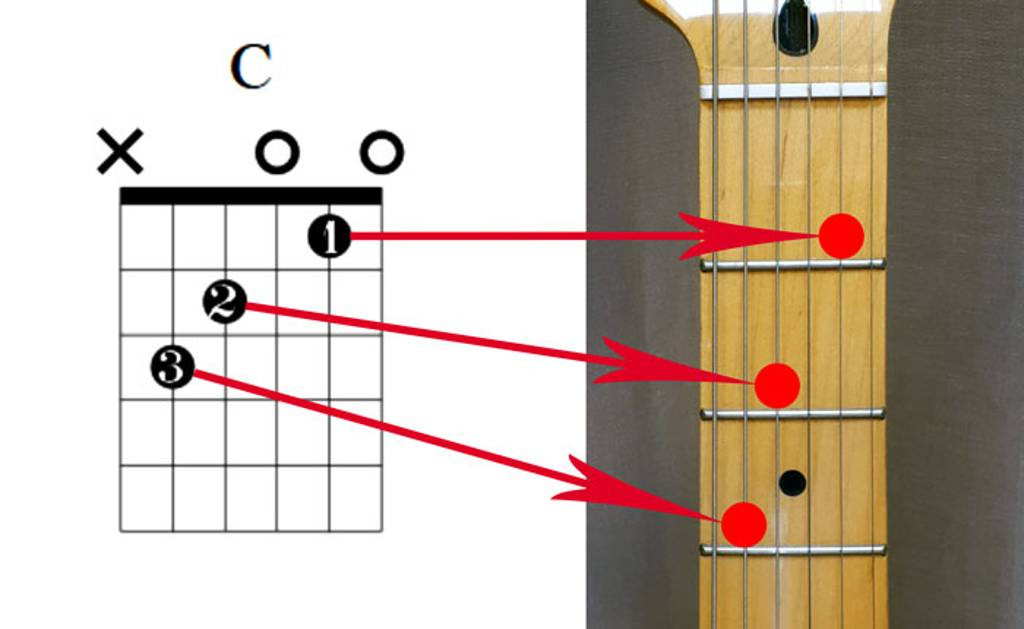 Understanding guitar chord diagrams for beginners
Understanding guitar chord diagrams for beginners
In a chord diagram:
- Vertical lines represent the guitar strings (from the thinnest, high E string on the right to the thickest, low E string on the left).
- Horizontal lines represent the frets. The top line is the nut (the start of the fretboard), and frets are numbered downwards.
- Numbers within circles indicate which finger to use:
- 1: Index Finger
- 2: Middle Finger
- 3: Ring Finger
- 4: Pinky Finger
- An “x” above a string means that string should not be played or strummed.
- An “o” above a string indicates an open string, meaning it should be played without fretting.
7 Common Guitar Chords Every Beginner Should Master
With an understanding of chord types and diagrams, let’s explore seven common guitar chords that are fundamental for any beginner guitarist.
1. A Major Chord
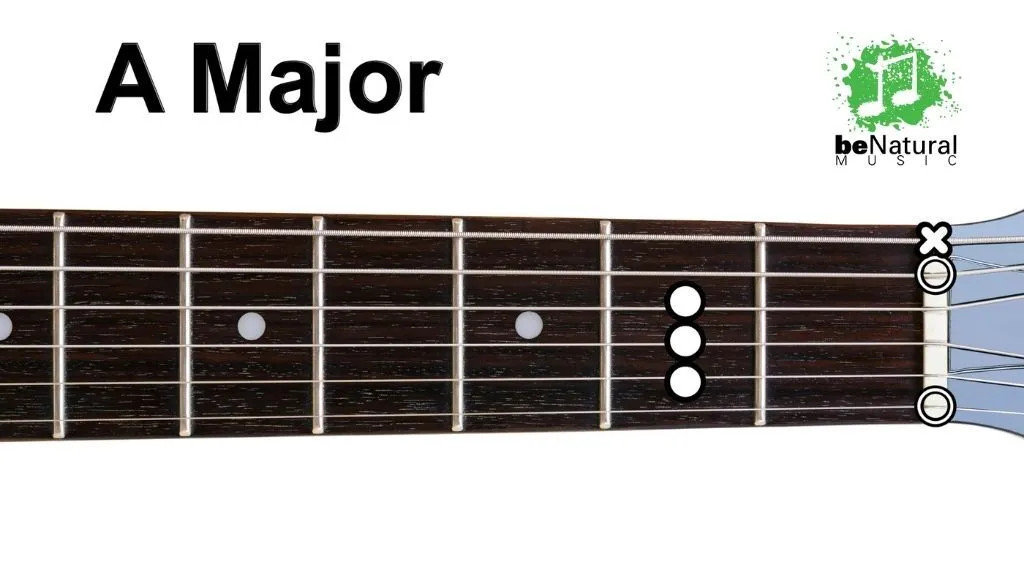 Diagram of A major guitar chord for beginners
Diagram of A major guitar chord for beginners
The A major chord is a foundational chord, often one of the first learned by beginners. Its relatively simple fingering and frequent use in popular music make it an excellent starting point.
How to play A Major:
- Place your index finger (1) on the 2nd fret of the D string.
- Place your middle finger (2) on the 2nd fret of the G string.
- Place your ring finger (3) on the 2nd fret of the B string.
- Strum from the A string (5th string) downwards, avoiding the low E string (6th string).
2. C Major Chord
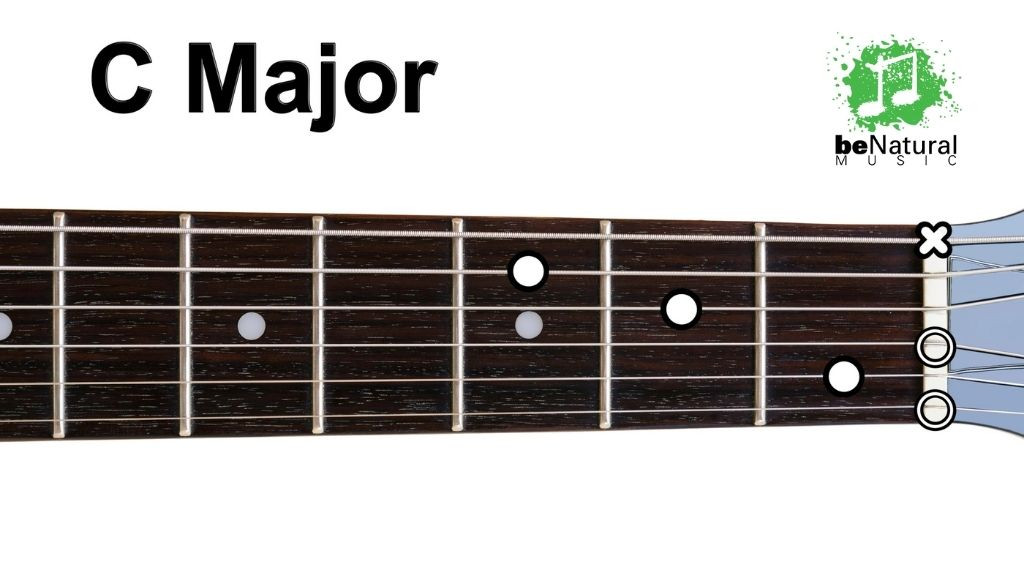 Visual guide to C major guitar chord for learners
Visual guide to C major guitar chord for learners
The C major chord is incredibly popular and versatile, appearing across countless genres. Its bright and cheerful sound makes it a staple in many songs.
How to play C Major:
- Place your index finger (1) on the 1st fret of the B string.
- Place your middle finger (2) on the 2nd fret of the D string.
- Place your ring finger (3) on the 3rd fret of the A string.
- Strum from the A string (5th string) downwards, avoiding the low E string (6th string).
3. G Major Chord
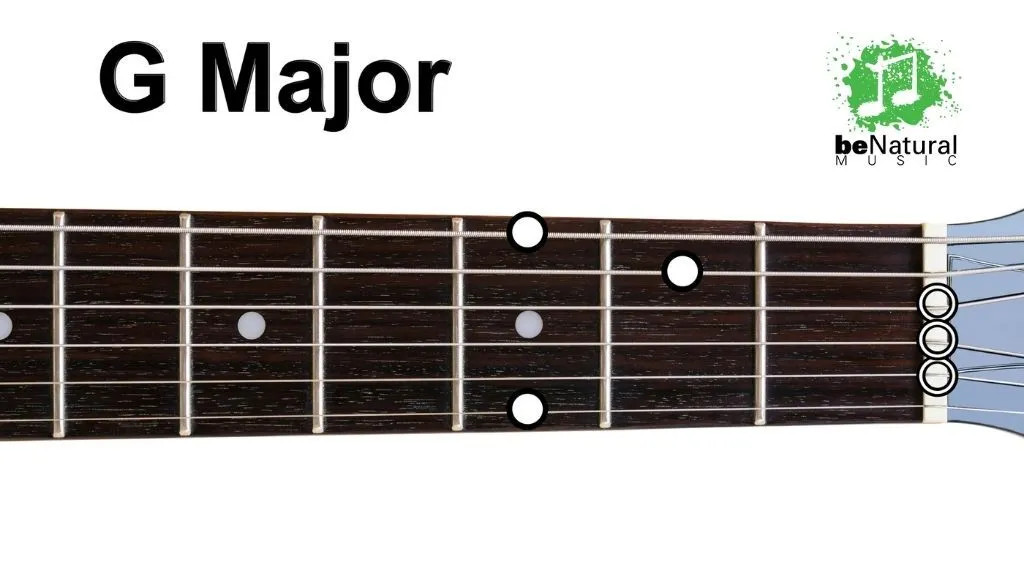 Instructional image for G major guitar chord position
Instructional image for G major guitar chord position
The G major chord is a powerful and full-sounding chord, essential for many songs. While it can be slightly trickier for beginners due to the finger stretch, practice will make it comfortable.
How to play G Major:
- Place your middle finger (2) on the 2nd fret of the E string (6th string).
- Place your index finger (1) on the 2nd fret of the A string (5th string).
- Place your ring finger (3) on the 3rd fret of the high E string (1st string).
- Strum all six strings.
Tip: Practice transitioning between G major and other common chords like C and D major to improve chord changes.
4. D Major Chord
 Simple diagram for D major guitar chord for beginners
Simple diagram for D major guitar chord for beginners
The D major chord produces an optimistic and uplifting sound, widely used in pop, country, and folk music. It’s another relatively easy chord for beginners to learn.
How to play D Major:
- Place your index finger (1) on the 2nd fret of the G string.
- Place your middle finger (2) on the 2nd fret of the high E string.
- Place your ring finger (3) on the 3rd fret of the B string.
- Strum from the D string (4th string) downwards, avoiding the A and low E strings (5th and 6th strings).
5. E Major Chord
 Easy to follow E major guitar chord chart
Easy to follow E major guitar chord chart
The E major chord is unique because it utilizes all six strings, creating a rich and resonant sound. Despite this, it’s not overly complicated to learn, making it a great chord for beginners.
How to play E Major:
- Place your index finger (1) on the 1st fret of the F string (3rd string).
- Place your middle finger (2) on the 2nd fret of the A string (5th string).
- Place your ring finger (3) on the 2nd fret of the D string (4th string).
- Strum all six strings.
6. A Minor Chord
 A minor guitar chord diagram for new players
A minor guitar chord diagram for new players
If you’ve already learned A major, A minor will feel very familiar. With a slight finger adjustment, you can transition from major to minor effortlessly. The A minor chord has a more somber, melancholic tone compared to A major, making it popular in ballads and emotive songs.
How to play A Minor:
- Place your index finger (1) on the 1st fret of the B string.
- Place your middle finger (2) on the 2nd fret of the D string.
- Place your ring finger (3) on the 2nd fret of the G string.
- Strum from the A string (5th string) downwards, avoiding the low E string (6th string).
7. B Minor Chord
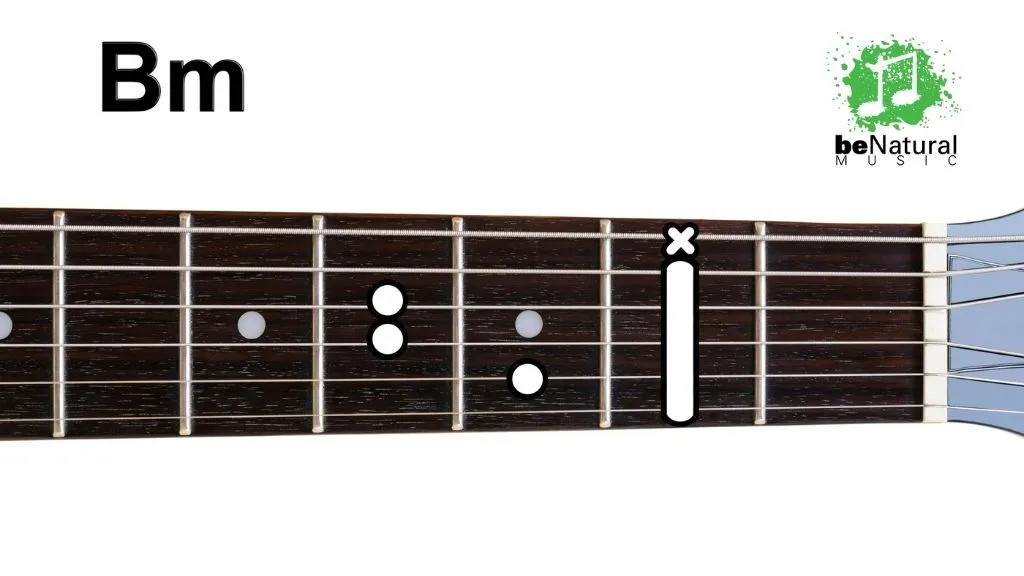 Step-by-step guide to B minor guitar chord for beginners
Step-by-step guide to B minor guitar chord for beginners
B minor is an introductory barre chord, slightly more challenging than open chords but a great starting point for learning barre chord technique. Mastering B minor opens up a new dimension in your chord vocabulary.
How to play B Minor:
- Use your index finger (1) to barre across all five strings (E, A, D, G, B) at the 2nd fret.
- Place your ring finger (3) on the 4th fret of the A string (5th string).
- Place your pinky finger (4) on the 4th fret of the D string (4th string).
- Place your middle finger (2) on the 3rd fret of the B string (2nd string).
- Strum from the A string (5th string) downwards, avoiding the low E string (6th string).
Tips for Smooth Chord Transitions
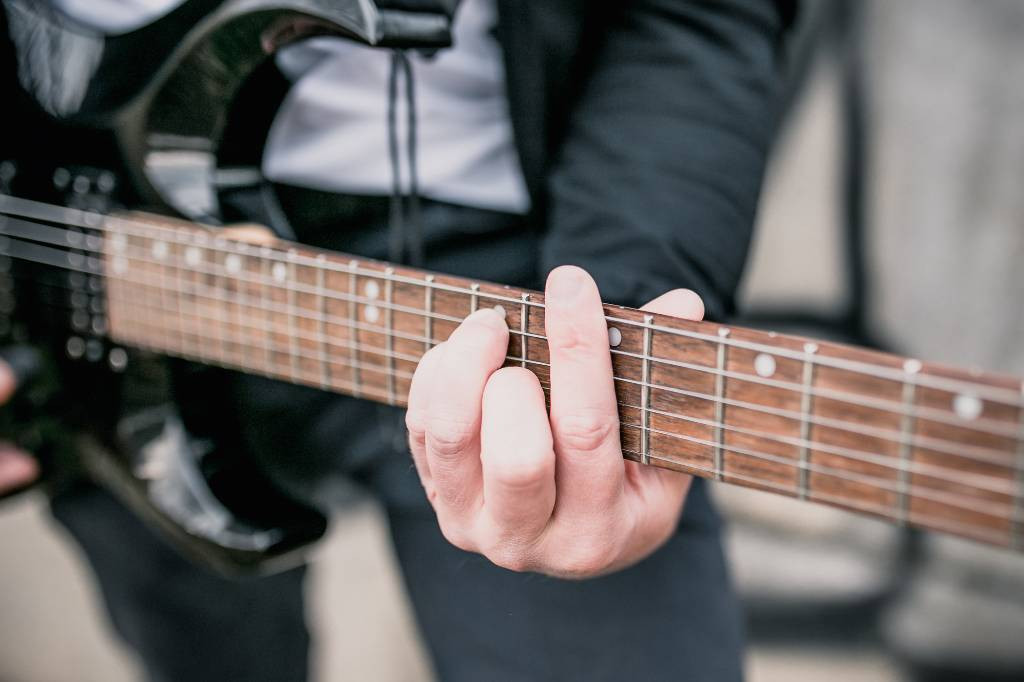 Guitarist practicing chord transitions for smoother play
Guitarist practicing chord transitions for smoother play
One common hurdle for beginner guitarists is changing between chords fluidly. Effective practice is crucial to overcome this and develop smooth transitions. A metronome is an invaluable tool for practicing chord changes.
Start by setting the metronome to a slow tempo. Practice switching between two chords in time with the metronome clicks. Focus on clean and accurate chord changes rather than speed initially. As your transitions become smoother, gradually increase the tempo.
For personalized guidance and accelerated progress, consider taking guitar lessons from a qualified instructor. A teacher can provide tailored advice based on your current skill level and identify specific areas for improvement in your chord transitions and overall technique.
Ready to Advance Your Guitar Skills?
Once you have a solid grasp of these common guitar chords, you’ll find that learning more complex chords and songs becomes significantly easier. Consistent practice is key to mastery. Dedicate time each day to practice your guitar chords, and you’ll be amazed at your progress.
If you’re looking to deepen your guitar knowledge and skills, Be Natural Music, with locations in Santa Cruz and Cupertino, offers both in-person and online guitar lessons for students of all levels. Our experienced instructors are passionate about music education and can guide you through everything from the basics to advanced guitar techniques.
Contact our instructors today to learn more about lesson pricing, schedules, and how we can help you achieve your musical goals.
